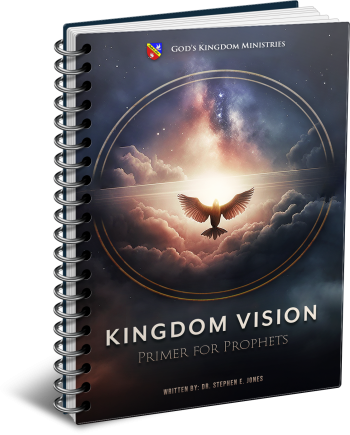Latest Posts
View the latest posts in an easy-to-read list format, with filtering options.

These are basic biblical themes that are necessary in order for prophets to understand what the biblical prophets have already prophesied.
Category - General

To have a full Kingdom vision, one must understand the three parts of salvation that correspond to the three main feast days as well as to man’s spirit, soul, and body.
Paul writes in 1 Thess. 5:23, 24,
23 Now may the God of peace Himself sanctify you entirely; and may your spirit and soul and body be preserved complete [holokleros, “whole, complete”], without blame at the coming of our Lord Jesus Christ. 24 Faithful is He who calls you, and He also will bring it to pass.
Paul had a Hebrew perspective, though he ministered among Greeks—and, with the help of Luke, the Greek doctor, also wrote his epistles in Greek. The Greek (pagan) view was based on the idea that man was a dichotomous being, having a fleshly body and a spiritual soul. On the other hand, the Hebrew view was based on the idea that man was a trichotomous being, having a body, a soul, and a spirit.
Paul makes it clear throughout his letters that our soul came from Adam, who “became a living soul” (1 Cor. 15:45; Gen. 2:7, KJV). He says further that the soul is fleshly, or carnal, because it is the offspring of the first sinner, Adam. He calls the soul “the old man” (Eph. 4:22, KJV; Col. 3:9, KJV), treating it as a “man” having a conscious identity. The NASB renders it “the old self.”
As baptized believers, we are to put the old man to death and transfer our identity to “the new man” (or “new self”), as we read in Eph. 4:24 and Col. 3:10. This new conscious identity is not the same person as the old man but is “a new creature” (2 Cor. 5:17). A “new creature” is not a new monster but is a new creation, or a different creation, a new entity with a different mind or consciousness.
Hence, believers are no longer the people that they were when they were born naturally from natural parents. They are now children of God, having been begotten by God through the Holy Spirit. Though we still occupy the same body at the present time, our personhood (identity) has changed from soulish to spiritual. No longer residing in the soul, which is dead, our conscious identity now resides in our spirit.
Paul’s concept of soul and spirit is derived from the law of blood in Lev. 17:11,
11 For the life [nephesh, “soul”] of the flesh is in the blood…
To put it another way, “the fleshly soul is in the blood.” Secondarily, we might also say that “the fleshly life is in the blood,” indicating that the life we live as soulish beings—derived from Adam—is carnal, or fleshly, or “natural,” being associated with the “nature” of the original creation. Hence, both the KJV and the NASB translate psuchikos with the word “natural” in 1 Cor. 2:14. More accurately, psuchikos should be rendered “soulish,” because it is derived from psuche (or psyche), which means “soul.”
But as believers, we are no longer of the original “natural” creation, nor are we any longer soulish creatures descended from Adam. We are instead spiritual, because the Holy Spirit has begotten within our spirit a new man that is spiritual. 1 Cor. 2:14, 15 says,
14 But a natural [psuchikos] man does not accept the things of the Spirit of God, for they are foolishness to him, and he cannot understand them, because they are spiritually appraised. 15 But he who is spiritual [pneumatikos] appraises all things, yet he himself is appraised by no one.
The soulish mind cannot comprehend spiritual things. The deep things of God and His wisdom are foolishness to him. Yet the spiritual mind comprehends all things.
Lev. 17:11 tells us that the soul is in the blood.
Our spirit (not to be confused with the Holy Spirit, which is God’s Spirit) is associated with our breath, for the Hebrew word ruach has a double meaning: spirit and breath. Hence, when God breathed “the breath of life” into Adam, He gave Adam a spirit (ruach), yet Adam was identified as a living soul.
By contrast, Jesus Christ was made (from the beginning) “a life-giving Spirit” (1 Cor. 15:45). In other words, God did not form Jesus as an adult from the dust of the ground and then breath into His nostrils the breath of life. No, Jesus was begotten, not formed. There was no two-step process in His case.
We ourselves, having been born first as soulish beings in the likeness of Adam, must be “born again,” as they say. That is, the Holy Spirit must overshadow us and beget us with holy seed from God Himself, and we must then transfer our identity to that new creation man. In this way our identity is transferred from the soul to the spirit.
Being born twice is a two-step process for us, but the end result is the same as with Jesus Christ, because the quality of the seed in our second begetting is the same, having come from the same Father.
The bottom line is that we are spirit, soul, and body, but our conscious identity is now in our spirit. The body is our physical, visible part that is in our flesh. The soul is in the blood and is associated with our flesh—not our spirit—for it is the fleshly, carnal soul (Lev. 17:11). Our spirit, pictured as breath, is the innermost part of our being, which comprehends the wisdom of God and does not consider it to be foolishness.
The soul, then, is not spiritual, as the Greeks thought in their carnal religious view. The soul is linked to the flesh. Hence, Paul said that the soulish man is carnal, not spiritual. If we are to understand Paul’s teaching, we must reject the Greek view of man’s nature and adopt the Hebrew view that is established in the law.
The tabernacle of Moses and the temple of Solomon were each divided into three parts: the Outer Court, the Holy Place, and the Most Holy Place, in which the presence of God made His abode. We are temples of God (1 Cor. 3:16). The Outer Court of the temple pictured the body; the Holy Place pictured the soul; the Most Holy Place pictured the spirit.
From this, we can see that man is not dichotomous but is a trichotomous being.
We also note that when these structures were built, it was necessary that the Most Holy Place be filled with the presence of God. So long as the Most Holy Place was devoid of His presence, it represented a non-believer. But when God came down to make His abode in the Most Holy Place, it became the model for an ideal Spirit-filled believer.
God does many things progressively in three steps, following the law of two or three witnesses that establish all things (Deut. 19:15; 2 Cor. 13:1). So also, there are three feasts in which the Israelite men were to appear before God each year (Exodus 34:23). Through Passover, our spirit is justified; through Pentecost, our soul is sanctified; through Tabernacles, our body is glorified.
The term “salvation” encompasses all three of these. Hence, there is a salvation of the spirit, of the soul, and of the body.
This is also the “Highway of Holiness” (Isaiah 35:8), pictured in the tabernacle and temple as the path to God’s presence. It begins at the Outer Court, which is the realm of Passover, with its brazen altar (for justification) and its laver (water baptism).
It then extends through the door to the Holy Place, with its Table of Showbread, Lampstand, and Altar of Incense, which are elements of Pentecost. We eat His bread (body), walk in His light, and have fellowship with God as we pray at the Altar of Incense. This is all designed for sanctification and the salvation of the soul.
Finally, there is the Most Holy Place behind the final veil, or curtain, where we see Him face to face (Exodus 33:11; 1 Cor. 13:12).
Under the Old Covenant, all could go into the Outer Court to be justified by faith, but only priests were allowed into the Holy Place. All may be justified in an Outer Court experience, but not all believers are priests. To be a priest is a distinct calling of God to be an intercessor between God and man. One does not simply join a denominational priesthood or clergy to be a priest of God, for there have been many corrupt people who have gone to seminary and have joined a priesthood as self-called people.
Because the Holy Place also serves as the type of the Pentecostal realm, it can be said generally that priesthood requires a Pentecostal anointing. This does not necessarily disqualify those who do not identify as Pentecostals. A Pentecostal anointing can be found among many who reject the Pentecostal label, yet who are led by the Spirit and hear God’s voice.
The essence of Pentecost is not about any of the gifts of the Spirit as such (including the gift of tongues). It is about hearing God’s voice, for this was the main feature of that first Pentecost at the foot of Mount Sinai, where the people heard God’s voice (Deut. 5:4). However, many of the Israelites refused to hear His voice (Exodus 20:19), fearing that they might die in the fire of God. Hence, they were disqualified from the Pentecostal experience and its priestly calling as intercessors.
The third and final salvation is the glorification of the body, which comes by entering the Most Holy Place. Paul says in 2 Cor. 3:18 that we are transformed by beholding Him with an unveiled face. The fire and glory of God transforms us fully into His image, so that we can survive the magnitude of His glorious presence.
To qualify to enter the Most Holy Place requires being part of the body of our “great High Priest” (Heb. 4:14). At the present time, being imputed righteous by New Covenant faith, we may enter His presence freely on the level that we often do. But there is a time yet to come when the body will be perfected and glorified and “preserved complete” (1 Thess. 5:23). In Rom. 8:23 Paul refers to this time as “the redemption of our body.”
This is the third and final salvation that fulfills Paul’s vision of the Kingdom in regard to spirit, soul, and body.
When we look at the Highway of Holiness in the tabernacle, we can view it either through man’s eyes or through God’s eyes. Insofar as man’s structure is concerned, we enter the Outer Court (body realm), then proceed to the Holy Place (soul), and finally to the Most Holy Place (spirit), which is the innermost part of our nature.
However, God reverses this order when it comes to salvation. We are first justified in our spirit (Most Holy Place), then sanctified in our soul through the baptism of the Spirit (Holy Place), and finally glorified in our body (Outer Court).
To have a clear Kingdom vision, it is necessary to see both patterns, as they are equally valid in their own domains.